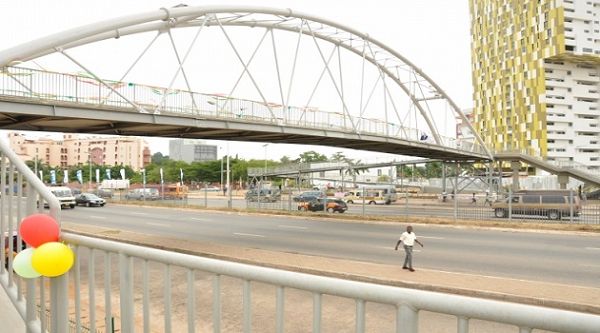
Safety and convenience, in footbridge use
The arguments have been that pedestrians aren't using footbridges along major routes of the country. The question is, "Why?"
Why do passers-by prefer to scale over barricades along the median of highways, rather than use footbridges provided? Why do people prefer to squeeze through any available openings in the concrete walls separating multiple lanes of major roads, than safely climb footbridges to cross?
Advertisement
Why have footbridges, meant as safe passage ways over busy highways, turned into hawking, trading and business enclaves? Are people sacrificing their safety for convenience? is it the convenience of making it fast by scaling the dividing walls and running quickly through speeding vehicles, instead of the minutes spent climbing and crossing safely? Why do pedestrians act the way they do and who is to blame?
During the Adentan agitation over the uncompleted footbridges, there were those who said, "Even when the government completes the footbridges, they will not use them!" In essence, they were saying that the agitation was 'much ado about nothing'!
That statement, however, shows a failure of our institutions in charge of roads and highways, from the Ministry of Roads and Highways which decides, commands and allocates resources for the construction of specific road infrastructure, to the Ghana Highway Authority (GHA) that undertakes the works and are supposed to engage people along highways under construction, to the National Road Safety Commission (NRSC), the lead agency in charge of safety on roads.
The assemblyman for the West Adentan electoral area is of the view that the GHA failed by its inability to engage residents along the N4 highway at the time it was being constructed.
"If residents had been consulted, maybe we would have suggested a tunnel beneath the highway for pedestrians to easily manoeuvre," he said during one of the neighbourhood meetings on the six skeletal, uncompleted footbridges dotting the skyline.
His views are telling, in that they show the current demands of people for their road infrastructure.
Apart from safety considerations, people want to cross conveniently. Thus, footbridges should not merely be provided for safety, but should be convenient for users.
They must be convenient for users to scale over in seconds; particularly when a person, by the nature of his or her business, needs to quickly commute when dealing with clients.
An example of this is the Pamprom Junction, that is the traffic light before the Kaneshie Market. On a typical day, spare parts dealers prefer to use openings in the concrete walls rather than the footbridges.
Footbridges must be convenient for the sick and people living with disability hence, the Ghana Federation of Disability Organisations (GFDO) concerns on the completion of the six footbridges.
Because they are not convenient to use, footbridges are fast becoming white elephants adorning highways in the country.
But what is the role of the NRSC in all these? The commission is a statutory agency to lead in championing, promoting and coordinating road safety activities in the country. It details its functions nicely on its website.
It is to undertake nationwide road safety education, information and publicity; develop long-term road safety and promote road safety research.
With these laudable objectives, one would have thought that road fatalities, interactively presented on its website, would not be up to 1,710, from January to September 2018.
The issue is, people have not really felt the commanding leadership of the NRSC in their challenges with the use of roads and highways.
The Adentan issue, for instance, should have been taken up by the commission, with the commission lobbying for the completion of the infrastructure.
They should have lobbied until they were hoarse for the ministry to commit the resources for the completion of the bridges.
Now as it stands, it seems the commission is quite adroit in collating statistics after death, when they should have rather used research to press home safety needs for the government to commit resources to meet them.
And while at it, I believe it is insensitive to remember victims of road accidents in a jovial manner. Why smile at a victim’s remembrance day?
A picture on the website captioned: “NRSC joins AMA to mark victims remembrance day”, has key figures smiling.
Remembering victims of road accidents, whether alive or dead, is no smiling affair!
Writer's email: [email protected]



